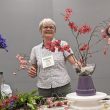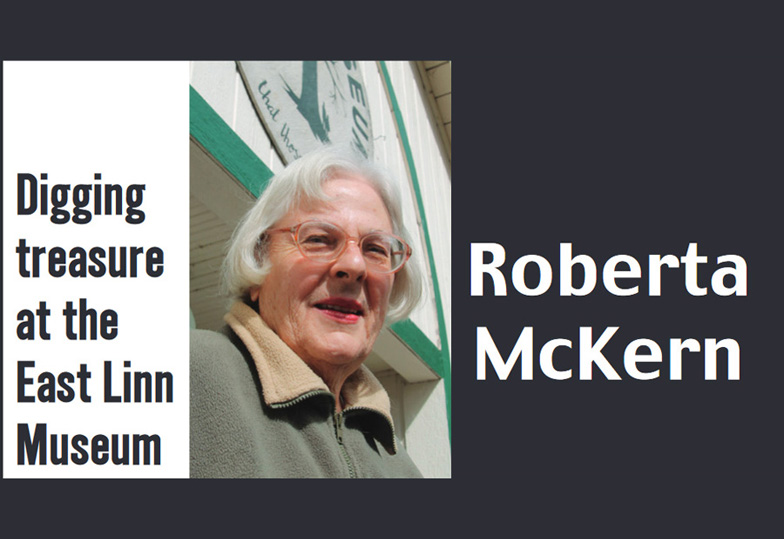By Roberta McKern
For The New Era/Lebanon Local
We’ve come to the seasonal change when wintry weather nips at the warmth of memories – a good time to refresh ourselves with an inspiring walk through the East Linn Museum.
However, the museum will be closed in December and January, reopening, we hope, from 11 a.m. to 4 p.m. the first Thursday of February.
This is as usual during the winter. However, some of its older volunteers may not be back in 2023 for health reasons – their own or of family members.
But, in the meantime, we can think of the museum and find inspiration through objects that evoke recollections of our youth. Holiday family dinners, in this case.
Thoughts may begin, let’s say, with spooners and celery vases. They weren’t used in our childhood, but you have to start somewhere. Still, the museum has three of the former and one of the latter.
Celery vases are clear glass containers that would resemble oversized goblets if their rims weren’t zig-zagged or crinkled. They were used just as their names imply: to hold teaspoons or celery stalks. Little old ladies we once knew who were old enough to add five years to their age to appear more venerable might have used them.
What was the etiquette? Did someone at a boarding house politely ask, “Will you please pass the spooner?” or just reach for one? And were celery vases, like serving dishes, passed around the table so stalk lovers could help themselves?

Such questions likely didn’t occur to us children as we looked at spooners and celery vases on what-not shelves. Filled with flowers or dried weeds, they were regular vases to us. Now they’re examples of formerly common items becoming obsolete, just like, some would say, our childhood memories. And yet, like those spooners and celery vases, we want to save our memories, perhaps to savor them again like a good holiday dinner.
What do we remember of Thanksgiving or Christmas dinners with relatives? We might think back 70 or so years ago to the anticipation of the superlative meals our mother or grandmother prepared to celebrate the seasonal gratitude of harvests. Sure, there would be turkey, dressing, mashed potatoes and gravy. Dinner could not do without that universal quartet. Vegetables could reflect the older practice of growing varieties for canning or to hold over for spring, storing them properly in a cool place like a root cellar. Home-canned string beans and mashed turnips likely showed up along with store-bought peas and corn. Pumpkin pie became squash pie with a long, gray- green hubbard squash.
The 1950s seemed to be a great time for peculiar Jell-O salads. Some bilious color combination involving orange Jell-O, grated carrots and green celery fragments frosted with mayonnaise would often appear on the table. The worst case we ever heard of was a cherry Jell-O/salmon concoction made by a woman who supposed anything in any Jell-O would work.It didn’t!
Related to celery vases and spooners, small, occasional dishes scattered across the table held jams, jellies, pickles and olives, as well as the necessary cranberry sauce. The jams, jellies and pickles represented a cook’s canning skills. Strawberry and blackberry jam or jelly enhanced homemade dinner rolls. Corn relish, pickled crab apples and pickled peaches added their piquant tartness and often appeared only at holiday feasts. And celery sticks graced low, long, narrow, decorative dishes, reflecting the old celery vases.
The table, with extra leaves added to accommodate guests, would be crowded with good things to eat. In the kitchen cut-up turkey filled platters like those seen at the museum. The table was set with the best china (a red moss rose pattern from Montgomery Ward), with plated silver flatware ready to go.
But, among the relatives, one family couldn’t arrive on time. Even if they only had to go up one hill and down the other, they would be at least a half-hour to 45 minutes late. And, of course, one never-tardy uncle wanted his dinner right on time. The men ended up waiting in the front room, talking guns, new cars or politics.
The older ones ignored the new-fangled invention of television, which promised more football in black-and-white on a 19-inch screen.
By and by, a grandfather’s voice might be heard pushing a political point with “As McAdoo said … .” No one cared what McAdoo said, because grandpa would argue one side of the question and then the other. In fact, he’d probably have been satisfied arguing with his reflection in the mirror over the fireplace as long as he won. (We had to look up this “McAdoo.” Turns out he was William McAdoo, Woodrow Wilson’s son-in-law, a successful politician in his own right.)
In the meantime, we might remember the women in the kitchen discussing family matters, the high cost of the year’s turkey and Jell-O salad recipes, while kids on the front porch watched for erring relatives. Finally came the jostling into the dining room, the blessing of dinner and the call to dig in.
Years later, we might realize the ladies received inadequate thanks for rising early to stuff the turkey and stick it in the oven after baking rolls and pumpkin, cherry, and lemon meringue pies the day before. As kids, we took family roles for granted, believing ours was the norm. Really, for those of us who grew up in small towns and visited with relatives, we seemed to be about average in our eyes.
After dinner, everyone would be stuffed and groggy. The ladies returned to the kitchen to straighten up, the kids escaped outdoors and the weary travelers, including the perpetual latecomers, sprawled on the davenport before the television, napping through the football game. The museum’s Motorola television reminds us of this. It fits into the 1950s.
In keeping with these memories of past holiday dinners, many aspects of which remain traditional, we thought to examine one of the museum’s old cookbooks: “Household Discoveries” (Success Press, 1908). It offers A-to-Z advice on running a home, from how to sweep a floor to building a complex set-up in a barrel to make vinegar. Considering the poisons used in various projects, being a chemist would have been an asset for any homemaker. The scientific approach to domesticity applied.
However, at the book’s end is a bonus: “Mrs. Curtis’s Cookbook.” It looks like a good one, although its only instructions regarding turkey takes but an eight-pound bird. Modern ones are double that size.
Its author, one Isabel Gordon Curtis, trusses the bird and roasts it first on the breast to brown its back, then flips it and roasts the breast, so it, too, is browned. Then she stuffs it with breadcrumbs and pre-boiled celery, adding flavor to taste. The stuffing goes into the neck area where the crop was. Though “Christmas is a-comin’, and the goose is getting fat” she doesn’t mention the latter. When it comes to holidays, that wasn’t Curtis’ real focus. And she wasn’t going to wrestle a 17-pound bird, anyway, one that would fill the oven of the museum’s cast-iron fail-safe range.
She mentions a Christmas cookie, but it’s a simple oatmeal variety full of currants and raisins. And she does have a recipe for plum pudding. Both may harken back to her younger years as a child growing up in Scotland. And, as she admitted in the cookbook’s introduction, her greatest interest was in baking bread.
This leads to the following story.
When Curtis was young, yeast bread fascinated her. Where she lived in Scotland, households made scones or oat cakes, but yeast-rising breads came from professional bakeries. When cousins from Canada visited her family, she listened attentively to their descriptions of making “American” bread.

After her mother took the cousins sightseeing, leaving her alone, Curtis saw her chance. Taking two shillings from her savings, she went to the bakery and purchased ten pounds of flour and a cupful of yeast. Back home, she mixed her bread, kneading it until her arms ached. She patted the dough into flat, round pans and popped the loaves into the oven, stoking the stove to keep the bread baking at a high heat. And she waited and waited and waited.
Finally, she removed the hard, brown discs that looked, she said, like ones used for curling. Their crusts could not be broken with an axe. She had missed the point calling for bread to rise.
What to do? She didn’t want anyone to know of her mistake. If she buried it in the garden, someone might dig it up. However, near the garden stood a shed with a difficult-to-access attic. So that’s where she tossed her bread.
Some years later, a windstorm flattened the shed, exposing her handiwork. No one could make out what the brown lumps were. One guess: meteorites.
Her cookbook’s recipes read much more hopefully. The museum has two copies of “Household Discoveries,” so the book also had some success here.
Most of the cooks we remember – our grandmothers and mothers, for example – relied primarily on “by guess and by golly,” concocting dishes from experience or inspiration. “By guess” meant “Hmm, what did I put in that? It’s good. I’ll have to guess what I did,” while “by golly” was shorthand for “Golly, that was awful. We won’t try that again!” Some cooks were mostly very good, and others had times when they needed Mrs. Curtis’ help.
Now, when we look back on the holiday dinners of our childhoods, we’ve gained respect for those cooks and for our relatives who added to the specialness of festivities just by being there.
At any time of the year, a walk through the East Linn Museum can remind us of those times we thought would never end. May we have a good holiday and stay healthy.
The museum reopens in February. As of now, its schedule remains 11 a.m. to 4 p.m. Thursdays, Fridays and Saturdays. That’s our hope, anyway.





